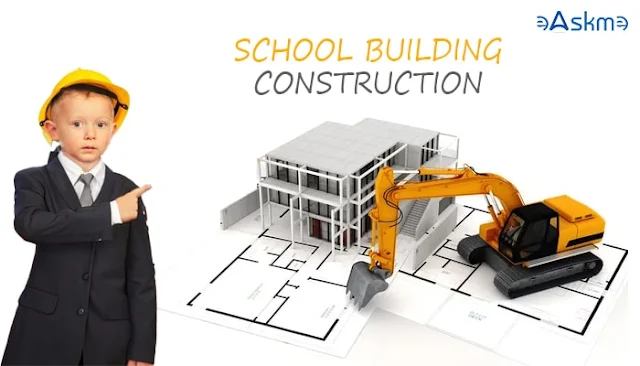The construction of schools stands as a pivotal endeavor, shaping educational environments for generations.
The meticulous planning, design, and execution of such projects demand scrupulous attention to detail to ensure safety, functionality, and an enriching setting for both students and educators.
In this discourse, we shall delve into the vital guidelines for realizing successful school construction initiatives, addressing various facets that require careful consideration.
 |
| School Construction: Essential Guidelines for Success: eAskme |
Site Selection and Preparation:
At the inception of any school construction undertaking, the selection of a suitable location takes precedence.
Site choice necessitates an evaluation of factors such as accessibility, proximity to residential zones, and the presence of indispensable infrastructure such as roads and utilities.
It is imperative to conduct comprehensive geological and environmental assessments to identify potential challenges that may manifest during construction.
Furthermore, adequate site preparation, encompassing tasks such as clearing, grading, and ensuring proper drainage, is crucial to forestall potential complications.
Budgeting and Funding:
Budgeting constitutes the linchpin of successful school construction.
The establishment of a pragmatic budget is paramount, one that encompasses all facets of the project, encompassing construction expenses, materials, labor, and unforeseen contingencies.
For sustainability, schools ought to explore a gamut of funding options, ranging from public funds and grants to private partnerships.
Meticulous financial planning and vigilant oversight are indispensable in averting cost overruns and associated delays, which can disrupt the academic calendar.
Architectural Design and Spatial Planning:
Effective school design transcends aesthetics, placing a premium on functionality and educational objectives.
Collaboration with seasoned architects assumes utmost importance to craft spaces that facilitate learning, prioritize safety, and imbue flexibility for future needs. The delineation of adequate classroom dimensions, communal areas, and administrative spaces is imperative.
Moreover, the design must encompass energy-efficient attributes, aiming to curtail long-term operational expenses and environmental impact.
Safety Measures and Regulatory Compliance:
The paramountcy of ensuring the safety of students and staff looms large in school construction endeavors.
Adherence to local building codes and regulatory provisions is non-negotiable. This entails strict adherence to fire safety standards, accessibility mandates, and seismic considerations in regions prone to seismic activity.
Adequate security protocols, inclusive of surveillance systems and controlled access points, should also find integration, conferring a secure learning milieu.
Integration of Technology:
In the contemporary digital age, technology assimilation assumes centrality in school construction.
Schools must be equipped with contemporary infrastructure to support modern pedagogical techniques and digital learning tools.
This entails provisions for high-speed internet connectivity, interactive whiteboards, and an ample number of power outlets within classrooms.
Additionally, forward-thinking conditions for future technological enhancements must be factored in to maintain a competitive edge in the ever-evolving educational landscape.
Environmental Sustainability:
The adoption of sustainable construction practices figures prominently in school construction endeavors aimed at diminishing ecological footprints.
The incorporation of energy-efficient HVAC systems, solar panels, and green roofing surfaces can substantially lessen energy consumption and subsequent operational outlays.
Furthermore, the selection of environmentally amiable construction materials and the institution of recycling and waste-reduction protocols contribute to a more ecologically mindful campus and underscore a commitment to environmental stewardship.
School Bathrooms and Restroom Partitions:
While frequently overlooked, school bathroom facilities wield considerable influence over the overall school ambiance.
Ensuring the presence of sufficient and well-maintained restrooms is imperative to safeguard students' comfort and hygiene. In the realm of school construction planning, due attention must be accorded to the design and siting of bathrooms.
A special focus must be trained on middle and high school restroom partitions, as they furnish privacy and structure within the restroom realm.
Robust and easily maintainable materials should find favor in the selection of restroom partitions to ensure longevity and streamline upkeep.
Adequate ventilation and plumbing infrastructure should also receive requisite emphasis to bestow a gratifying restroom experience upon students and staff alike.
Project Management and Timelines:
Efficient project administration forms the bedrock of successful school construction initiatives. The employment of adept project managers, proficient in overseeing all phases of construction, from inception to fruition, assumes seminal importance.
Realistic timelines and milestones must be etched out to ensure the project remains on course and within budgetary bounds.
Open lines of communication amongst stakeholders, encompassing architects, contractors, and school administrators, are indispensable in addressing issues in a timely manner and averting setbacks.
Community Engagement:
Harnessing the involvement of the local community constitutes a fundamental facet of school construction endeavors.
It is imperative to apprise residents and parents of the project's progression and any potential disruptions.
Soliciting community input can offer invaluable insights and inculcate a sense of ownership in the undertaking.
Moreover, enlisting community participation in the planning and design phases can help tailor the school to cater to the unique requisites and preferences of the locale.
Quality Control and Maintenance:
Upon the culmination of construction, the commitment to quality remains unabated.
Regular maintenance and inspections are requisite to ensure the continued safety and functionality of school facilities.
Instituting a maintenance regimen that encompasses routine checks and rectifications is indispensable to protract the lifespan of the infrastructure.
Furthermore, involving school staff in identifying and reporting maintenance exigencies can expedite issue resolution.
Conclusion:
School construction serves as a multifaceted endeavor, necessitating judicious planning, budgeting, and execution.
By adhering to essential guidelines, educational institutions can cultivate safe, functional, and sustainable learning environments that foster student accomplishment.
From site selection to technology integration and community engagement, each facet assumes pivotal importance in the overall triumph of a school construction initiative.
By affording primacy to these tenets, educational establishments can proffer students and educators facilities that nurture growth, innovation, and a promising future.
Don’t forget to share it with your friends and family.
Don't forget to like us FB and join the eAskme newsletter to stay tuned with us.
Other handpicked guides for you;










